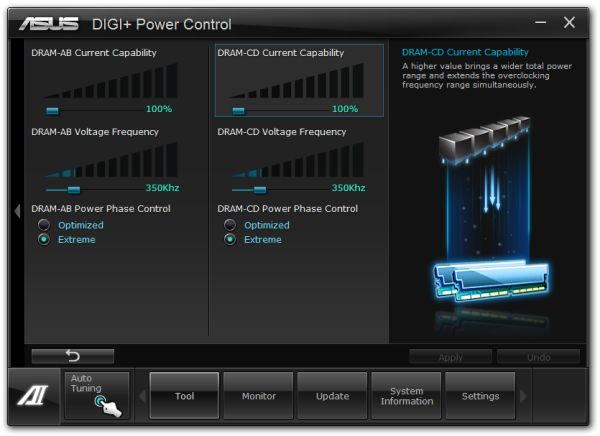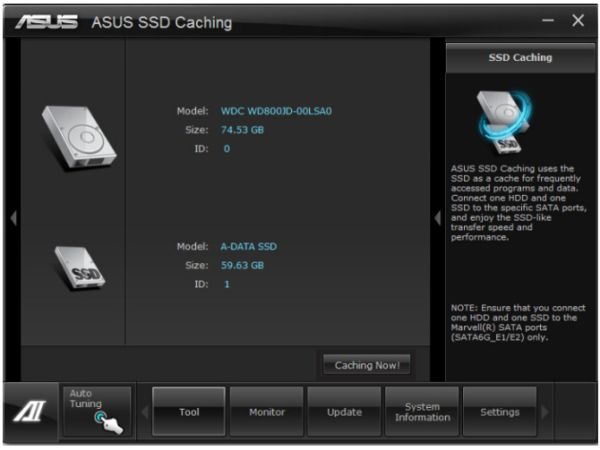Sandy Bridge-E and X79 – The ASUS P9X79 PRO Review
by Ian Cutress on November 14, 2011 3:01 AM EST- Posted in
- Motherboards
- Asus
- X79
Board Features
| ASUS P9X79 Pro | |
| Size | ATX |
| CPU Interface | LGA2011 |
| CPU Support | Intel Second Generation Core i7 Sandy Bridge-E |
| Chipset | Intel X79 |
| Base Clock Frequency | 100.0 - 100.3 MHz |
| Core Voltage | Auto, offset and manual, 0.8 V to 1.7 V |
| CPU Clock Multiplier | Auto, 12x to 57x |
| DRAM Voltage | Auto, 1.20 V to 1.99 V |
| DRAM Command Rate | Auto, 1T to 3T |
| Memory Slots |
Eight DDR3 DIMM slots supporting up to 64 GB Up to Quad Channel Support for DDR3, 800-2666 MHz |
| Expansion Slots |
2 x PCIe Gen 3 x16 2 x PCIe Gen 3 x8 2 x PCIe Gen 2 x1 |
| Onboard SATA/RAID |
2 x SATA 6 Gbps, Support for RAID 0, 1, 5, 10 4 x SATA 3 Gbps, Support for RAID 0, 1, 5, 10 |
| Onboard |
2 x SATA 6 Gbps (Marvell) 4 x SATA 3 Gbps (PCH) 2 x SATA 3 Gbps (PCH) w/ SSD Caching 6 x Fan Headers 1 x Front Panel Header 1 x Front Panel Audio Header 1 x S/PDIF Out Header 4 x USB 2.0 Headers 1 x USB 3.0 Header 1 x EPU Switch 1 x TPU Switch Power / Reset / Clear CMOS Buttons + Debug LED |
| Onboard LAN | Intel Gigabit 82579V |
| Onboard Audio | Realtek ALC898 |
| Power Connectors |
1 x 24-pin ATX connector 1 x 8-pin 12V connector |
| Fan Headers |
2 x CPU Fan Header 4 x Chassis Headers |
| IO Panel |
6 x USB 2.0 4 x USB 3.0 1 x BIOS Flashback Button 1 x Intel Gigabit Ethernet 1 x Optical S/PDIF Out Connector 2 x Power eSATA 6 Gbps Bluetooth v2.1 Audio Jacks |
| BIOS Version | 0709 |
| Warranty Period | 3 Years |
The Intel NIC is very welcome on a high end platform, as well as one of the later models of Audio Codec by Realtek, which is represented in the DPC Latency performance. The BIOS Flashback feature (Update BIOS via USB without CPU or DRAM) is an excellent feature I hope ASUS ports to all future chipsets, as well as the SSD Caching option even though it is not part of the X79 specifications. Six fan headers is always good, as well as Debug LED and power/reset buttons, however as mentioned previously I would have liked another Ethernet port.
As always, ASUS motherboards have a 3 year warranty.
In The Box
IO Shield
Manual
Driver CD
1 x Long SLI Cable
1 x Rigid Tri-SLI Connector
6 x SATA cables, locking, right angled
Q-Connectors
While ASUS have spent money on the cables and the SLI connectors, on a product at this price, I would have liked to see a long CrossFireX cable and a USB 3.0 front bracket.
Software
Software installation, as always with ASUS, is straightforward. Clicking Install-All on the CD menu under the Driver section does the drivers, and then once again under the Software for software. ASUS bundles Google Chrome and Norton Antivirus with the CD as well which annoyingly ask to be installed – users have to deselect them if they do not want them. Daemon Tools Pro is also on the CD, though users have to install it individually.
The main stalwart of ASUS software is still here, under a slightly redesigned ASUS AI Suite II. With the depth of X79 and all the new features ASUS have added, we have to get to grips with the whole software. Overclocking function is nothing spectacular here, with Auto Tuning and slider adjustment being identical to previous implementations. With the advent of DIGI+ VRM for the memory, we now get options to adjust this, as well as the DIGI+ for the CPU.
Energy efficiency options also get a revamp in their modes, and in terms of fan controls, each of the four chassis fan headers are double-ramp adjustable, and the two CPU fan headers act under the one control.
The two new areas of ASUS brand technology come in the form of ASUS USB 3.0 Boost, and ASUS SSD Caching. Let us go over each one in turn.
ASUS USB 3.0 Boost
Readers of this year’s content may cast their minds back to the several ASRock boards I have reviewed, and their XFast USB software. This was a simple bit of software that modified and optimized the Windows7 USB driver to allow for faster operation. ASUS have gone in a similar theme, but taken it several steps further.
On the simple end, there are multiple USB protocols to use. Windows, by default, uses BOT – a simple linear process protocol for file transfer. By a simple rewrite of the driver, such as the ASRock implementation, a motherboard manufacturer can implement a ‘Turbo’ mode, which acts like a more multithreaded environment.
Now, if the USB device or enclosure has certain classes of controllers (LucidPORT USB300-REV2, ASMedia ASM1051E, ASMedia ASM1051U, ASMedia ASM1054), a protocol known as UASP (USB Attached SCSI Protocol) can be implemented. This protocol is more efficient, and allows multiple, concurrent commands, rather than the linear BOT sequence. This is what USB 3.0 Boost is aimed at.
Initially, each USB 3.0 device will need to be set to Turbo or UASP as required, but devices are remembered for repeat use. Unfortunately, I do not have access to a device to test this UASP performance; however I was able to see it in action at a recent ASUS event.
ASUS SSD Caching
Users of Intel’s Z68 Smart Response Technology that were dismayed when SRT was not a part of the X79 specifications will be overjoyed to see something similar to Intel’s operation on ASUS’ X79 range. By placing two compatible drives (typically a mechanical HDD and a formatted SSD) in the appropriate SATA ports, the software and hardware implementation will let the SSD act as a cache, in order to improve loading times to the mechanical HDD, just like Intel’s RST.
The potential here is possibly using any extra RAM as a cache. With the abundance of 4x4GB kits for use in such a system, from my own personal experience, almost half of that would never be used – the most memory I’ve ever used is 7.9 GB, which included a hundred or so internet tabs, background software, and whilst playing F1 2010 at full settings. If ASUS were to license a RAMDisk software technology to allow users to create a RAMDisk, and then use that in an SSD caching technique, then we are on to a winner. Even better if a user has decided to fill up the memory slots with 32 GB. Admittedly, this would be lost every time the system is rebooted, and would have to be remade, but for users who leave their system on all the time for various reasons, it could provide useful.





















55 Comments
View All Comments
RegGam - Monday, November 14, 2011 - link
SSD caching looks like a killer feature. It seems like it's the key new feature this year. But, I am surprised that ASUS chose not to use Intel SRT. Any idea why? Or, is this a rebranded solution from NVELO?Also, I don't get why the "SSD Cache" ports are 3Gb/s SATA. All the new SSDs will be 6Gb/s so shouldn't the 6Gb/s ports be dedicated to caching? Or, let me choose!
ASUSTechMKT - Monday, November 14, 2011 - link
SRT is not supported natively on the PCH for X79 as such we phased in our ASUS SSD Caching implementation. To clarify the SATA controller used does offer SATA6G support.RegGam - Monday, November 14, 2011 - link
That's great news. (article should be updated). So, I can use any SSD with any SATA 3G or 6G port. So, when can we see a comparison of intel SRT against this solution? And, if it's not Dataplez, compare against that too.Also, when will this be available in Europe (France)?
RegGam - Monday, November 14, 2011 - link
Aww sh!t, just looked at the snapshots. It's a Marvell controller feature. If its the same as their hyperduo junk, I'm no longer interested. Thats not even real caching, just concatenation. I was so excited too. :-(ASUSTechMKT - Wednesday, November 16, 2011 - link
Actually it is the same as SRT which and in realworld performance compairson you acheive the same improved results ( reduced boot times, significantly faster read performance, imporved application response. There is also the advantage compared to SRT that you are no limited on the cache volume size.Overall it is a solid implementation and the cool part is you can still locally run a primary volume and then have your secodary volume ( storage be cached.
mailman65er - Friday, November 18, 2011 - link
> Actually it is the same as SRTHardly... that so-called "caching" feature based on the Marvell (I think they call it hyber duo), does not even perform real caching - its already been exposed. junk... fail...
use SRT or dataplex...
CodeToad - Friday, December 2, 2011 - link
I think you are incorrect on this. Yes, there are two Marvell ports stated to run at 6G. Like you I'd never use that. But there are two 6G ports available on the main, and not Marvell.chrone - Monday, November 14, 2011 - link
with that hefty price, i wonder no dual LAN teaming support. :PASUSTechMKT - Wednesday, November 16, 2011 - link
Cost we phased in a number of more readily useable options than dual lan ( which is only used by a very small % ( of course we do have it on two other boards Deluxe and WS which even features dual Intel lan ).Keep in mind things like 6 pwm fan headers with advanced control for 5 of those headers means a higher bom cost to put the header , the super I/O controller and other aspects little items like this all add up and you have to make the calls on what to phase in over what not to.
wharris1 - Monday, November 14, 2011 - link
I wonder why the 2600 was not used as a comparison CPU for the multithreaded benchmarks in lieu of the 2500.